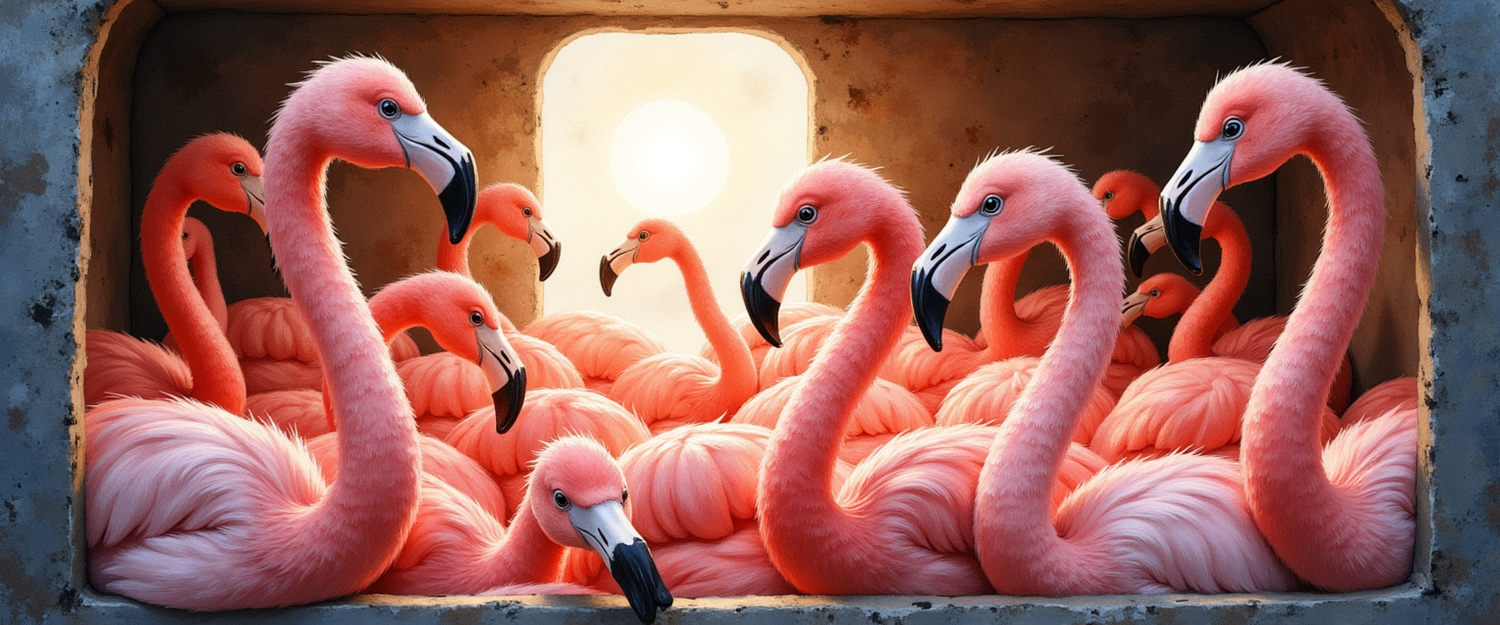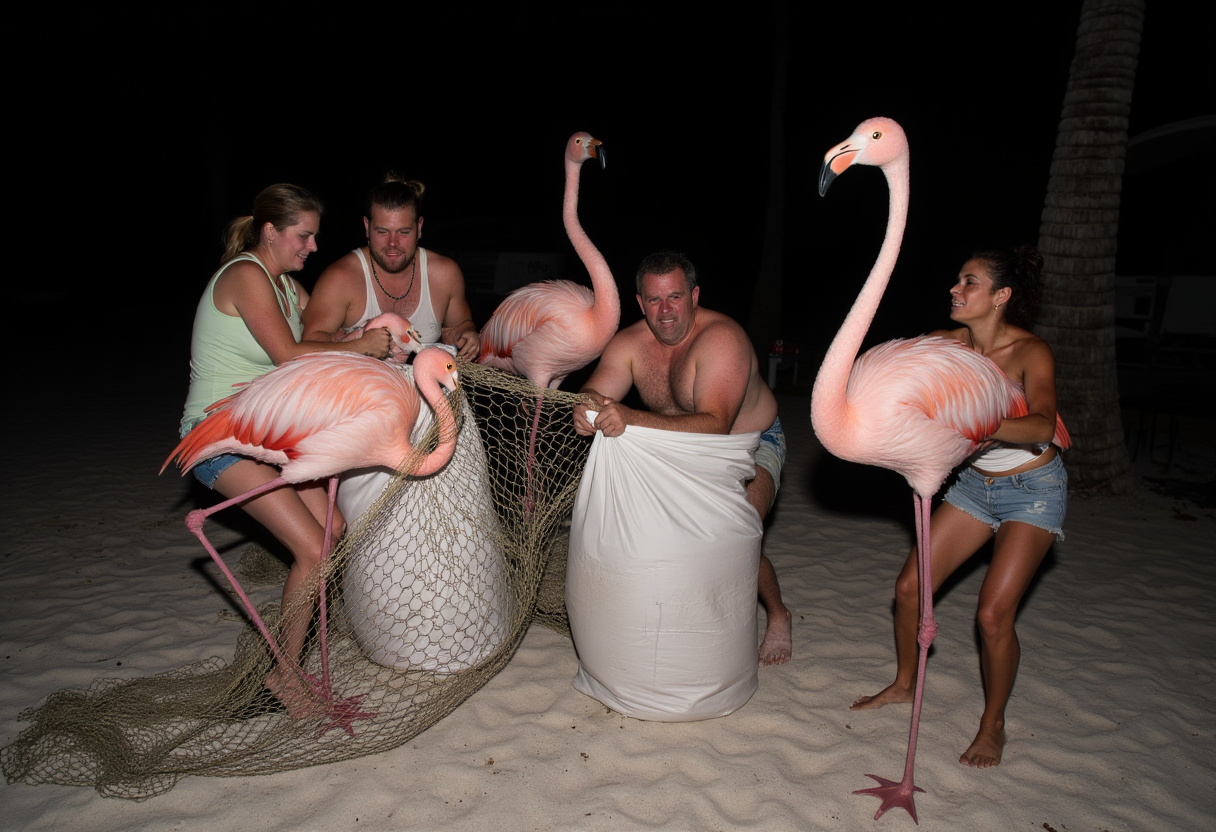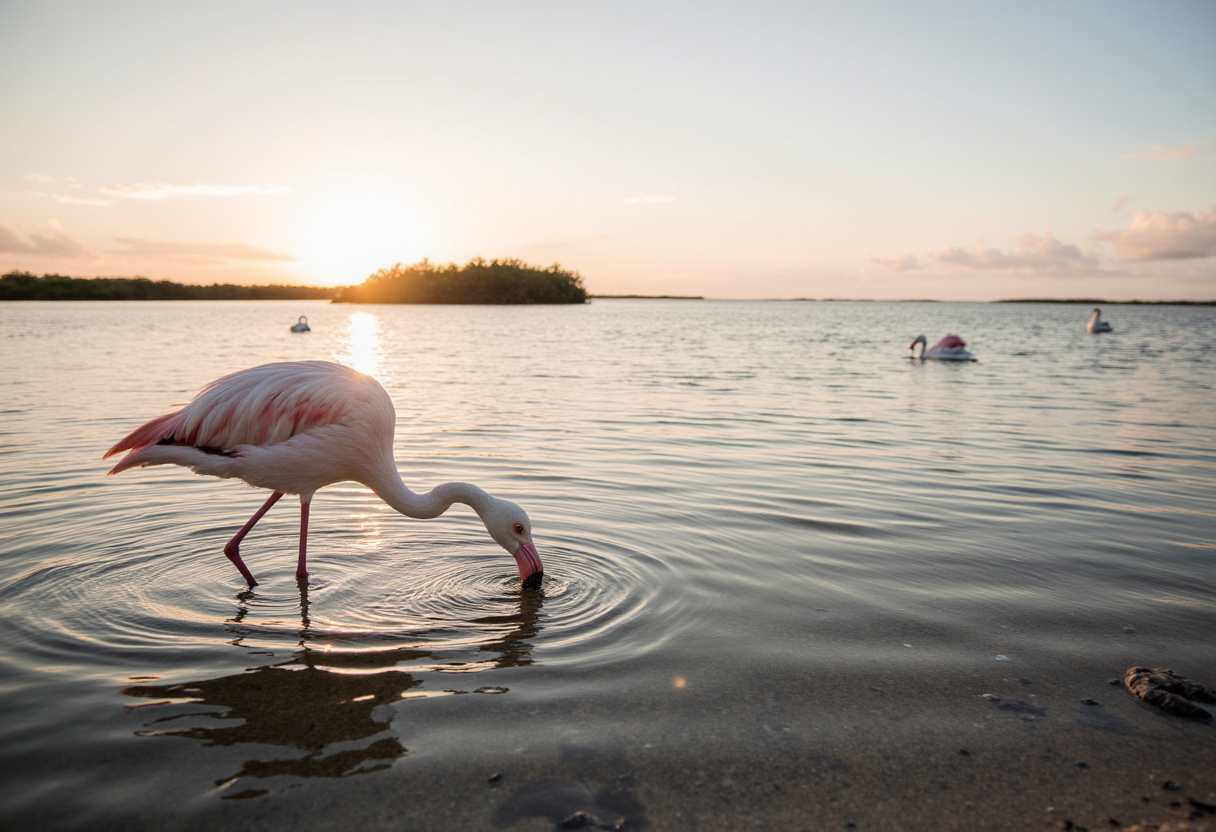The Great Flamingo Heist
Group of Flamingos
The Great Flamingo Heist
Key West.
The very name conjures sun-drenched streets, pastel houses, and a reckless fondness for the unconventional. It’s a town where ordinary etiquette takes a holiday and eccentricity is the local currency—so when a strange,
Splashy incident involving captive flamingos unfolded in the fall of 2023, and even longtime residents did a double-take.
This is a story about flamingos, art, and a small group of islanders who decided those pink birds belonged to the wild—not a resort’s lawn display.
This is the story of The Great Key West Flamingo Heist,
A caper so audacious—and so delightfully absurd—it could only have been dreamed up by a tight-knit crew of island eccentrics who called themselves the Flamingo Liberation Front.
The Genesis of a Grand Plan: A Flock Forsaken
Our tale begins not with a bang but with a long, artistic sigh. On the sun-washed porches of Key West, a group of septuagenarian artists, poets, and general bon vivants exchanged stories and grievances between gin and glassware.
They were led by Agnes “Aggie” Penhaligon—retired abstract expressionist, habitual kaftan wearer, and part-time curator of neighborhood drama—whose ire was fixed on a new development: the Coral Reef Mega‑Resort & Spa.
Aggie would point, flamingo‑pink nail flashing, at the resort’s manicured lawns and snap, “Look at them, children—those poor flamingos, turned into lawn ornaments!”
The resort’s flock—advertised as a dozen or so Greater Flamingos (note: species identification later clarified)—had been purchased to supply “upscale ambiance.”
To Aggie and her circle—among them Bartholomew “Barty” Finch, a resourceful former marine biologist, and Dolores “Dolly” Rodriguez, an ex‑burlesque performer with a flair for theatricality—those birds were not décor.
scene of the Flamingo Liberation Front in a debate
They were living, breathing works of art, and their enclosure felt like a gilded cage.
At the resort’s “Tropical Paradise Luau Extravaganza,” complete with a particularly tragic limbo routine and enough plastic leis to strangle a buoy, the birds looked subdued. Their typically vivid pink—derived from carotenoid‑rich food in the wild—seemed oddly muted, a visual sign that something about their captive diet and environment was amiss.
“We simply must liberate them,” Aggie declared, eyes flashing above her reading glasses. “Find them a home where their beauty and natural behaviors—not resort cocktails—can flourish.”
And with that, plans were sketched on napkins, arguments about ethics were politely staged, and the Flamingo Liberation Front was born.
Assembling the A-Team (and the B-Team, and the C-Team…)
The Flamingo Liberation Front—so named with an equal part pride and mischief—knew this wasn’t a weekend arts-and-crafts project. You can’t simply scoop up a dozen long‑legged birds and hope for the best. This required planning, guile, and, as one conspirator put it,
“a measured supply of courage (and cocktails).”
Early meetings were more about principles than logistics: spirited debates over avian freedom, whether flamingos belong in a resort’s manicured lagoon, and which members should drive the getaway golf cart.
Dolly pushed for clandestine, ninja‑style theatrics (sequins optional). Barty, the group’s retired marine biologist, sketched migration maps and practical notes about flamingo behavior.
Aggie, true to form, doodled abstract rescue plans on cocktail napkins—convinced that a little artistic empathy might soothe the birds.
They eventually settled on a nearby, uninhabited mangrove isle west of Snipe Key as the ideal "artistic home": brackish lagoons, shallow mudflats that support the invertebrates flamingos favor, and the seclusion a flock might prefer.
The logistics question—how do you move twelve large, leggy flamingos across water without causing a panic or risking disease transmission?—generated three fanciful options:
"A rustic, dilapidated fishing trawler named the 'Salty Siren,' owned by Horace.
Option A: The Repurposed Fishing Boat. Barty suggested Horace’s battered trawler, the Salty Siren, retrofitted with padded enclosures and soft bedding.
Option B: A Fleet of Decorated Golf Carts. Dolly imagined a dramatic, ribbon‑adorned procession through town—spectacle over stealth—until someone pointed out that golf carts don’t float.
Option C: The “Sweet Talk” Approach. Aggie favored coaxing the birds with calm music and gentle gestures, banking on flamingo social behavior to help the plan along.
They ultimately chose a hybrid: the Salty Siren for water transit, golf carts for the short land leg, and a plan to keep the birds calm during handling. Important editorial intervention: the original notion of a homemade "calming tonic" (chamomile + rum) is a dangerous oversimplification—do not attempt.
Any sedation or medical handling must be performed by a licensed avian veterinarian following regulations and quarantine protocols to prevent disease transfer and protect both captive and wild populations.
Addendum for readers: moving or releasing captive flamingos involves permits, veterinary checks, and coordination with wildlife authorities (federal and state).
For authoritative information on flamingo husbandry, diet that influences their pink color (carotenoids), and safe transport, consult resources such as the San Diego Zoo, Audubon Society, and your local wildlife agency.
Practical notes for the rewrite: break the options into clear subheads for scannability, include a small callout box titled “Responsible Relocation” summarizing permits, quarantine, and vet involvement, and insert links to reputable sources about flamingo species (Phoenicopterus spp. and related taxa) and diet that restores plumage color.
D-Day:
"A chaotic, low-light scene behind the Coral Reef Mega-Resort & Spa. Aggie, Dolly, and Barty are wrestling with large, floppy, half-sedated flamingos, trying to guide them into oversized, repurposed laundry bags.
The Night of the Pink Pillage
They picked a moonless Tuesday—Dolly swore the stars were aligned, Barty chose it for the low tide—ideal for slipping through the resort’s private lagoon under cover of darkness.
Armed with modified nets, padded crates, and Aggie's comically large repurposed laundry bags (“They’re breathable, darling!”), The Flamingo Liberation Front descended on the Coral Reef.
Their aim: remove the birds from an environment that treated them like static décor and bring them to a place where natural behavior and diet could restore their health and color.
Their first obstacle was mundane: the resort’s overnight security, a young man named Kevin who, like many of us, had been distracted by his phone.
Aggie enacted a diversion—a theatrical fainting spell and an impassioned plea about “lost mermaids”—while the rest slipped around back toward the enclosure.
What they hadn’t fully anticipated was the difficulty of handling long‑legged, large birds, even if they were calmer than usual.
Flamingos are surprisingly strong and awkward to contain; legs tangle, necks curl, and improvising with laundry bags proved clumsy at best. In the real world, any handling, sedation, or transport of flamingos must be performed or overseen by a licensed avian veterinarian and coordinated with wildlife authorities to avoid injury and disease transmission.
The Great Chase: Beak‑to‑Beak with the Law
As they were loading the last few birds onto carts for the short dash to the docks, an alarm cut through the night. Kevin—having realized the “lost mermaids” were a ruse—called the police.
The result was an absurd, slow‑motion chase: a caravan of septuagenarians ferrying half‑asleep pink birds through the narrow streets of Key West while a patrol car followed in bewildered pursuit.
Dolly blew playful kisses. Barty fussed over the birds’ comfort. Horace gunned the old trawler engine at the docks. The scene was part comedy, part farce, and entirely unforgettable to anyone watching from a late‑night bar or an upstairs balcony.
They reached the waterline just as officers closed in. The birds were transferred to the Salty Siren’s padded enclosure and the boat pulled away into the predawn hush. Over the roar of the motor, Aggie called back a triumphant, if unpolished, rallying cry: “Freedom for feathered friends!”
"Dawn breaking over a pristine, uninhabited mangrove island just west of Snipe Key. the rising sun casts a soft, golden glow. in the foreground, a liberated Greater Flamingo cautiously dips its bill into the clear, brackish water
A New Dawn for the Pink Paradox
Headlines the next morning screamed with glee and outrage: “PINK PERPS PILFER PLUMAGE! KEY WEST SENIORS SNATCH RESORT FLAMINGOS!”
The Coral Reef demanded the return of their expensive avian display. The Flamingo Liberation Front, however, was gone—at least from public view.
On the mangrove shore where they landed, the birds hesitated, then dipped bills into clear, brackish water. Over the following weeks, nourished on a natural diet rich in carotenoid‑bearing crustaceans and algae—foods known to influence flamingo color—the flock gradually regained brighter hues.
(Editorial note: restoring plumage color depends on diet and health; authoritative sources such as the San Diego Zoo and Audubon explain which foods supply the carotenoids that give flamingos their pink.)
Occasional sightings—a flash of pink among the mangroves, a distant, wailing call—kept locals smiling. The Flamingo Liberation Front became a beloved island legend, their story retold with increasing embellishment at happy hours and on guided walks.
Important reminder for readers: releasing captive birds into the wild is regulated and potentially harmful if done without veterinary checks, quarantine, and permits. Any real‑world rescue or relocation must be coordinated with wildlife authorities to protect both the birds and local ecosystems.
Occasional sightings followed—a flash of pink among the emerald mangroves, a long, plaintive call carried on the breeze—eliciting smiles and knowing nods from island locals who preferred legend to litigation.
The Flamingo Liberation Front slipped into Key West folklore: a band of eccentric retirees who staged one of the most theatrical acts of civic defiance the town had ever seen. Their story is retold with ever‑greater embellishment over happy hour mojitos, on walking tours, and in souvenir shop gossip.
Public records show no high‑profile prosecution in the aftermath (note: if pursuing this as factual reporting, verify court records and police logs). Whether officially charged or simply winked at by amused officers,
The group’s actions prompted a broader conversation about how flamingos and other birds are kept for displays, and about the responsibilities of people and institutions to provide proper, species‑appropriate care.
More than a caper about stolen birds, the Great Key West Flamingo Heist became a story about art, community,
and the idea that some elements of the natural world—especially charismatic birds whose pink color depends on a specialized diet—are too precious to be reduced to lawn ornaments.
If this piece inspires curiosity, learn more about flamingo species, their diet and color (carotenoids), and responsible wildlife stewardship from reputable sources such as the Audubon Society and San Diego Zoo.
And if you care about local wildlife, consider supporting licensed conservation efforts rather than attempting unsupervised rescues—real relocations require vets, permits, and quarantine to protect both birds and ecosystems.
"Thanks for reading. Until next time, keep exploring Florida's peculiar charm!"
Florida Unwritten Staff





